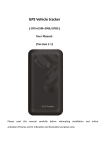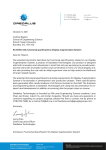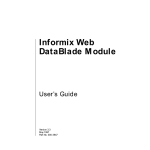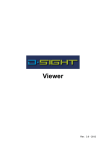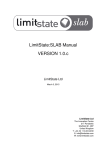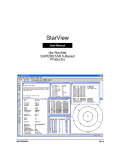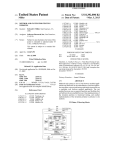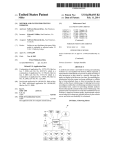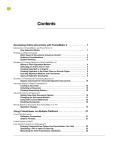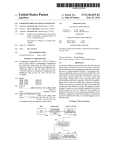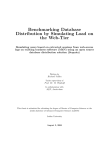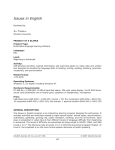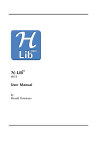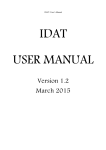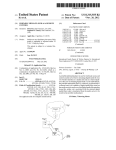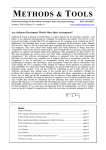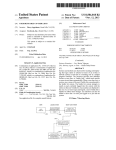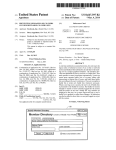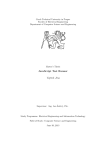Download (12) United States Patent
Transcript
US008683447B2
(12) United States Patent
(10) Patent N0.:
(45) Date of Patent:
Miller
(54)
(56)
METHOD AND SYSTEM FOR TESTING
WEBSITES
U.S. PATENT DOCUMENTS
5,974,572
6,002,871
6,044,398
6,138,157
6,151,599
6,157,940
6,185,701
6,393,479
CA (US)
Inventor:
Edward F. Miller, San Francisco, CA
(Us)
(73) Assignee: Software Research, Inc., San Francisco,
CA (US)
(*)
Notice:
Mar. 25, 2014
References Cited
(71) Applicant: Software Research, Inc., San Francisco,
(72)
US 8,683,447 B2
Subject to any disclaimer, the term of this
patent is extended or adjusted under 35
A
A
A
A
A
A
B1
B1
6,418,544 B1 *
7/2002
7/2002 Ramos et a1.
6,446,120 B1
9/2002 Dantressangle
6,549,944
6,587,969
6,601,020
6,662,217
(21) Appl. No.: 13/764,635
Weinberg et a1.
Duggan et a1.
Marullo et a1.
Welter et a1.
Shrader et a1.
Marullo et a1.
Marullo et a1.
Glommen et a1.
6,421,070 B1
6,522,995 B1
U.S.C. 154(b) by 0 days.
10/1999
12/1999
3/2000
10/2000
11/2000
12/2000
2/2001
5/2002
B1
B1
B1
B1
2/2003
4/2003
7/2003
7/2003
12/2003
Nesbitt et a1. ................. .. 714/43
Conti et a1.
Weinberg et a1.
Weinberg et a1.
Myers
Godfrey et a1.
(Continued)
(22)
Filed:
Feb. 11, 2013
FOREIGN PATENT DOCUMENTS
(65)
Prior Publication Data
W0
US 2013/0151600A1
(60)
2/2001
OTHER PUBLICATIONS
B. Strange, “The $60 Web-Testing Toolbox” Oct. 2006, Better Soft
ware, accessed Jun. 1, 2013 from <http://test.techWellcom/sites/de
Related US. Application Data
(62)
WO 01/10082 A2
Jun. 13, 2013
fault/?les/articles/XDDI1428?lelist?lename1i0.pdf>.*
Division of application No. 12/247,753, ?led on Oct.
8, 2008, noW Pat. No. 8,392,890.
(Continued)
Primary Examiner * James D Rutten
Provisional application No. 60/980,068, ?led on Oct.
(57)
15, 2007.
ABSTRACT
Methods and systems to test of Web broWser enabled appli
(51)
Int. Cl.
G06F 9/44
G06F 11/00
G06F 3/00
(52)
cations are disclosed. In one embodiment, a broWser applica
tion can alloW a user to perform test and analysis processes on
(2006.01)
(2006.01)
(2006.01)
a candidate Web broWser enabled application. The test
enabled broWser can use special functions and facilities that
are built into the test enabled broWser. One implementation of
US. Cl.
the invention pertains to functional testing, and another
implementation of the invention pertains to pertains to site
USPC ............ .. 717/127; 717/130; 714/25; 715/738
(58)
Field of Classi?cation Search
None
analysis.
See application ?le for complete search history.
12 Claims, 5 Drawing Sheets
USER
Hum
Pmau
mummy“
lMUII
W
am
m
Pram-MM‘:
PIS-III
nun-mum’ mm». Nana
IE XMJHTML REIDERING ENGINE
nVllld Oumml Int-ha
Nu!
g:
@
m BIEIIIHI Imtlm lm N805
COM
MBA/m
Mm
311 NW
mum-N5“
Mull
900N813 nun
US 8,683,447 B2
Page 2
(56)
“E-Commerce Reliability and Web Site Testing,” sides, presented at
the Third International Software Quality Week Europe 1999, Brus
sels, Belgium, Nov. 1-5, 1999, 14 pages.
“Expression Web SuperPreview”, Retrieved at <<http://expression.
References Cited
U.S. PATENT DOCUMENTS
6,684,204 B1
6,741,967 B1
6,754,701 B1
1/2004 Lal
5/2004 Wu et al.
6/2004 Kessner
6,775,644 B2
6,865,599 B2
8/2004 Myers
3/2005 Zhang
6,918,066 B2
10/2005 Liang
6,993,748
7,000,224
7,013,251
7,043,546
7,072,935
7,231,606
7,299,457
7,313,595
7,316,003
7,337,349
1/2006
2/2006
3/2006
5/2006
7/2006
6/2007
11/2007
12/2007
1/2008
2/2008
7,363,616 B2
7,461,346
7,752,326
7,757,175
7,849,162
8,032,626
8,095,882
8,327,271
8,392,890
8,495,585
B2
B2
B2
B2
B1
B2
B2
B2
B2
13, 2009, pp. 2.
“Expression Web SuperPreview”, Retrieved at <<http://visitmix.
com/News/Expression-Web-SuperPreview>>, Mar. 18, 2009, pp. 3.
“Firebug (Firefox extension)”, Retrieved at <<http://enwikipedia.
org.wiki/FirebugP(Firefoxiextension)>>, Jul. 18, 2009, pp. 1.
7/2005 Dutta et al.
6,954,922 B2
B2
B1
B1
B2
B2
B2
B2
B2
B1
B2
mircosoft.com/en-us/dd565874(printer).aspx>>, no later than Oct.
“First Browser Based Web Testing Tool Provides Accuracy Break
Schaefer
Osborne, II et al.
Nace etal.
Smith et al.
Kehoe et al.
Miller et al.
Marshall
Rust
Dulepet et al.
Braunels et al.
through,” Press Release, eValid, Inc., Sep. 6, 2000.
“Functional/Regression Test Tools”, Retrieved at <<http://www.
qcforum.org/viewtopic.php?id:14>>, Apr. 4, 2008, pp. 8.
“IBM Rational Functional Tester Proxy SDK Reference”, Retrieved
at <<htpp://publib.boulder.ibm.com/infocenter/rfthelp/v7r0m0/in
dex.j sp?topic:/com.rational.test.ft.proxy.api.help/ProxyApiRefer
ence/overview-summary.html>>, Oct. 9, 2009, pp. 5.
“Internet Explorer Developer Toolbar”, Retrieved at <<http://en.
wikipedia.org/wiki/InternetiExplorerideveloperiToolbar>>, Jun.
4/2008 Kalyanaraman
12/2008
7/2010
7/2010
12/2010
10/2011
1/2012
12/2012
3/2013
7/2013
1, 2009, pp. 2.
“Netrenderer”, Retrieved at <<http://ipinfo.info/netrenderer/index.
php?>>, Oct. 12, 2007, p. 1.
“Products.new”, Software Magazine, vol. 19, Issue 2, p. 67, plus front
Fildebrandt
Smit
Miller et al.
Davis et al.
Russell et al.
Kashi
Miller
Miller
Miller
page of magazine and one page advertisement, Sep. 1999.
ready, Set, eValid, advertisement, Application Development Trends,
www.adtmag.com, 2 pages, Nov. 2000.
“Record and Playback for IBM Rational Functional Tester 7.0 does
not Work on HTML Browser Menu Options”, Retrieved at <<http://
2002/0035498 A1
2002/0038388 A1
3/2002 Kehoe et al.
3/2002 Netter
2002/0109717 A1*
8/2002
Li et al. ....................... .. 345/744
2002/0138226
2003/0005044
2003/0053420
2004/0010587
9/2002
1/2003
3/2003
1/2004
Doane
Miller et al.
Duckett et al.
Altamirano et al.
A1
A1
A1
A1
2004/0039550 A1
2004/0054728
2004/0111488
2004/0261026
2005/0166094
2005/0203902
2005/0246153
2006/0005066
2006/0031663
A1
A1
A1
A1
A1
A1
A1
A1
www-01.ibm.com/support/docview.wss?uid:swg2125183>> Oct.
2/2004 Myers
3/2004
6/2004
12/2004
7/2005
9/2005
11/2005
1/2006
2/2006
1999.
Rust
Allan
Corson
Blackwell et al.
Davis et al.
Genkin et al.
Brauneis et al.
Peller et al.
SR Announces New Testing Application Suite for the Web: STW/
Webz, Press Release Software Research Inc., 2 pages, Feb. 12, 1996.
“Testing Techniques Newsletter (TTN),” On-line edition, Jul. 1999,
pp. 1-18.
“Website Validation Technology”, conference slides, the 12th Inter
national Software Quality Week 1999, San Jose, CA, May 24-28,
1999, 20 pgs.
2006/0048214 A1*
3/2006 Pennington et al. ............ .. 726/5
2006/0069961 A1
2006/0101404 A1
3/2006 Kalyanaraman
5/2006 Popp et al.
2007/0006036 A1
1/2007 Devas et al.
2007/0115984 A1*
5/2007 Kumar et al.
2007/0124305 A1
2007/0150556 A1
2007/0234217 A1
2008/0184102 A1
2009/0228805 A1
2009/0249216 A1
5/2007
9, 2009, p. 1.
“Selenium-RC”, Retrieved at <<http://seleniumhq.org/docs/0Sise
leniumirc.html>>, Oct. 13, 2009, pp. 21.
“Software Research Announces CAPBAK/Web to Test Reliability of
Web Sites”, Press Release Software Research Inc., 4 pages, Jul. 26,
“Automated Testing with TestComplete 8”, Automated Testing Tools,
http://smartbear.com/products/qa:tools/automated-testing. down
loaded Nov. 20, 2011, 3 pages.
“DejaClick”, DejaClickiWikipedia, the free encyclopedia, http://
. 370/392
Smith et al. ................... .. 707/10
6/2007 Fukuda et al.
10/2007 Miller
7/2008 Selig
9/2009 Ruehle
10/2009 Charka et al.
en.wikipedia.org/wiki/Dej aclick, downloaded Nov. 20, 2011, 2
pages.
“Interface WebDriver”, WebDriver, http://selenium.googlecode.
com/svn/truck/doc s/ api/j ava/org/openqa. seleniurn/WebDriver. htrnl,
downloaded Nov. 20, 2011, 7 pages.
“Internet Explorer”, Wikipedia, the free encyclopedia, http://en.
wikipedia.org/wiki/InternetiExplorer, downloaded Dec. 9, 201 1, 26
pages.
OTHER PUBLICATIONS
“Keynote Kite”, Learn aboutiKeynote Internet Testing Environ
Notice ofAllowance of US. Appl. No. 13/764,628 mailed May 15,
ment, http://kite.keynote.com/how-it-works.php, downloaded Nov.
20, 2011, 3 pages.
2013.
“Keynote Kite”, Test Website lTesting Web Applications lApplication
Performance TestingiKite, http://kite.keynote.com, downloaded
“Browser Compatibility Check for Internet Explorer Versions from
5.5 to 8”, Retrieved at <<http://my-debugbar.com/wiki/IETester/
Nov. 20, 2011, 1 page.
HomePage>>, Copyright 2001-2009, pp. 2.
“Keynote Systems Introduces AJAX-Based Testing Tool for Rich
Web 2.0 Sites”, http://in.sy-con.com/node/451642/print, down
“Check Browser Compatibility, Cross Platform Browser Test”,
Retrieved at <<http://browershots.org/>>, Jun. 9, 2005, p. 1.
“Conference Program & Expo Guide”, Vendor Technical Presenta
tion, Website Validation Technology (VT19), the 12th International
Software QualityWeek 1999, San Jose, CA, May 24-28, 1999, 2 pgs.
“Conference Tutorials Expo Sponsors”, conference information and
Website Validation Technology (VT19), the 12th International Soft
ware Quality Week 1999, San Jose, CA, May 24-28, 1999, 4 pgs.
“Document Object Model (DOM) Level I Speci?cation Version 1.0”
W3C, Oct. 1, 1998, pp. 1-169.
loaded Nov. 20, 2011, 2 pages.
“Keynote systems”, Keynote systemsiWikipedia, the free encyclo
pedia, http://en.wikipedia.org/wiki/Keynoteisystems, downloaded
Nov. 20, 2011, 4 pages.
“Open Source at Google”, Introducing WebDriver4Google Open
Source Blog, http://google-opensource.blogspot.com/2009/05/intro
ducing-webdriverhtml, May 8, 2009, 3 pages.
“Printable Watir Tutorial”, Printable TutorialiWatir4OpenQA
Wiki,
http ://wiki .openqa.org/display/WTlUPrintable+Tutoria1,
downloaded Nov. 20, 2011, 49 pages.
US 8,683,447 B2
Page 3
(56)
References Cited
OTHER PUBLICATIONS
eValid, “Subscription Test TeleServices, Custom Website Testing and
Validation, Web Site Quality Consulting,” presented at the Third
International Software Quality Week Europe 1999, Brussels, Bel
gium, Nov. 1-5, 1999.
“Project Home”, Project HomeiWatiriOpenQA Wiki, http://wiki.
Final Of?ce Action for US. Appl. No. 12/247,753, mailed Jul. 11,
openqa.org/display/WTIUProject+Home, downloaded Nov. 20,
2012.
2011, 2 pages.
“Selenium (software)” Selenium (software), Wikipedia, the free
encyclopedia,
http://en.wikipedia.org.wiki.Seleniumi(software),
downloaded Nov. 20, 2011, 3 pages.
“Selenium Documentation”, http://seleniumhqorg/docs, down
loaded Nov. 20, 2011, 3 pages.
“Selenium Users”, Selenium UserslGoogle Groups, http://groups.
google.com/group/selenium-users/about, downloaded Nov. 20,
2011, 2 pages.
Final Of?ce Action for US. Appl. No. 12/247,753, mailed May 16,
2012.
Finlay, “Web Testing Tools Break Out of Windows GUI”, SD Times,
www.sdtimes.com, 3 pages, Oct. 15, 2000.
Fruhlinder, Joshua, “Cross-Brower Web Application Testing Made
Easy”, Retrieved at <<http://www.ibm.com/developerworks/web/li
brary/wa-crossbrowser/>>, Dec. 18, 2007, pp. 11.
JavaScript, Wikipedia, Downloaded Aug. 14, 2011 pp. 1-20.
Marchetto, A.: Tonella, P: Ricca, F.;, “State-Based Testing of Ajax
Web Applications,” Software Testing, Veri?cation, and Validatin,
“Selenium-IDE”, Selenium-IDE-Selenium Documentation, http://
2008 1st International Conference on, vol., no., pp. 121-130, Apr.
seleniumhq.org.docs.02iseleniumiide.html#the-watfor-com
org/stamp/stampj sp?tp:&arnumber:4539539
mands-in-ajax-applications, downloaded Nov. 20, 2011, 46 pages.
9-11, 2008 doi: 10.1109/ICST.2008.22 URL:http://ieeexplore.ieee.
“SWExplorerAutomation (SWEA)”, WebiusiWebius Internet
Explorer Automation, http://webiussoft.com, downloaded Nov. 20,
Notice of Allowance for US. Appl. No. 10/041,768 mailed Feb. 8,
2011, 2 pages.
“Test Automation for Web Applications”, IntroductioniSelenium
Notice ofAllowance for US. Appl. No. 11/758,624 mailed Mar. 23,
Documentation, http://seleiumhq.org/docs/0liintroducinggsele
Notice ofAllowance for US. Appl. No. 12/247,753, mailed Aug. 26,
nium.html#brief-historyiof . . . , downloaded Nov. 20, 2011, 8
pages.
“TestComplete”, TestCompleteiWikipedia, the free encyclopedia,
http://en.wikipedia.org.wiki.Testcomplete, downloaded Nov. 20,
2011, 4 pages.
“Waitr GeneraliDiscussion”, DiscussionsiWatir GenerallGoogle
Group, http:// groups. google.com/group/watir-general/topics?tsc:2,
downloaded Nov. 20, 2011, 3 pages.
“Watir.com”, Watir.com|Web Application Testing in Ruby, http://
watir.com/, downloaded Nov. 20, 2011, 7 pages.
“Watir”, WatiriWikipedia, the free encyclopedia, http://en.
wikipedia.org.wiki/Watir, downloaded Nov. 20, 2011, 3 pages.
“Webdriver”, WebdriverlGoogle Groups, http://groups.google.com/
group/webdriver/ about, downloaded Nov. 20, 2011, 2 pages.
2007.
2010.
201 1.
Notice ofAllowance for US. Appl. No. 12/247,753, mailed Dec. 12,
201 1.
Notice ofAllowance for US. Appl. No. 12/795,553, mailed Sep. 27,
2012.
Of?ce Action for US. Appl. No. 10/041,768 mailed Aug. 23, 2006.
Action for US. Appl. No. 10/041,768 mailed Dec. 28, 2005.
Of?ce Action for US. Appl. No. 10/041,768 mailed Feb. 14,2005.
Of?ce Action for US. Appl. No. 10/041,768 mailed Jul. 2, 2004.
Of?ce Action for US. Appl. No. 10/041,768 mailed May 13,2005.
Of?ce Action for US. Appl. No. 10/041,768 mailed Jan. 16,2007.
Of?ce Action for US. Appl. No. 11/758,624 mailed Sep. 17, 2009.
Of?ce Action for US. Appl. No. 12/247,753, mailed Mar. 3, 2011.
Of?ce Action for US. Appl. No. 12/247,753, mailed Mar. 22,2012.
Advisory Action for US. Appl. No. 12/247,753, mailed Aug. 28,
“What is DejaClick?”, DejaClickTM by AlertSite®, http://www.
2012.
dej aclick.com/, downloaded Nov. 20, 2011, 2 pages.
Advisory Action for US. Appl. No. 10/041,768 mailed Sep. 9, 2005.
Of?ce Action for US. Appl. No. 12/795,553, mailed Mar. 8,2012.
Product Release Notes, CAPBAIQWeb (IE) for Windows NT and
Windows 2000, Mar. 21, 2000.
Product Release Notes, CAPBAIQWeb (IE) Ver. 1.5, Nov. 24, 1999.
Ajax (programming) Wikipedia Downloaded Aug. 11, 2011, pp. 1-4.
Author Unknown, “Successful Deployment of Ajax and OpenAjax”,
Originally published at www.openaj aZ.org, Archived Feb. 26, 2008 at
SalZmann, “Java Product News”, JavaWorld, www.javaworld.com/
<http://web.archive.org/web/20080226021111/http://www.
openajax.org/whitepapers/
Successful%20Deployment%20of%20Ajax%20and%OpenAjax.
php>.
javaworld/jw-l0-2000/jw-1020-newsbrief.html, 4 pages, Oct. 20,
Cugini et al., “Design of a File Format for Logging Website Interac
tion”, Retrieved at <<http://Zing.ncsl.nist.gov/cugini/webmet/?ud.
design-paper.html>>, Apr. 2001, pp. 9.
Document Object Model, Wikipedia, downloaded Jul. 7, 2011, pp.
2/toc.html on Oct. 31, 2000.
1-6.
Eaton, et al., “Position Paper: Improving Browsing Environment
Compliance Evaluations for Websites”, Retrieved at <<http://
conferenZe.dei.polimi.it/wq04/?nal/paper04.pdf>>, Oct. 9, 2009,
PP 6
Edward Miller, “WebSite Testing,” White paper, 2000 (printed on
Oct. 31, 2000).
Edward Miller, “WebSite Testing,” White paper, presented at the
Third International Software Quality Week Europe 1999, Brussels,
Belgium, Nov. 1-5, 1999.
eValid User Manual, v7, Software Research, Inc., May 21, 2007, 677
pgs.
eValid User Manual, v8, Software Research, Inc., Jan. 28, 2008, 894
eValid, “E-Commerce Reliability and Web Site Testing,” (with
2000.
Software Tech News, “WebSite Testing-Software Testing,” vol. 3,
No. 2, printed from http://dacs.dtic.mil/awareness/newsletters/stn3
The Third International Software Quality Week Europe 1999: Les
sons Learned, Seminar/Conference outline, Brussels, Belgium, Nov.
1-5, 1999.
The Thirteenth International Software & Internet Quality Week, Reg
istration Materials for Seminar/ Conference, San Francisco, CA, May
30-Jun. 2,2000.
U.S. Appl. No. 12/247,753, ?led Nov. 18, 2008.
US. Appl. No. 12/795,553, ?led Jun. 7, 2010.
Xiong et al., “Testing Ajax Applications with Selenium”, InfoQ,
www.infoq.com/articles/testing-ajax-selenium>, Sep. 25, 2006, 8
pages.
Of?ce Action for US. Appl. No. 12/247,753, mailed Oct. 26, 2012.
US. Appl. No. 13/672,599, ?led Nov. 8,2012.
U.S. Appl. No. 13/764,628, ?led Feb. 11,2013.
W3C Document Object Mode, W3C, www.w3.org/dom, Jan. 6,
2009, pp. 1-3.
Notice ofAllowance for US. Appl. No. 13/672,599, mailed Oct. 21,
2013.
attached video graphics), presented at the Third International Soft
ware QualityWeek Europe 1999, Brussels, Belgium, Nov. 1-5, 1999.
* cited by examiner
US. Patent
Mar. 25, 2014
Sheet 1 of5
US 8,683,447 B2
100
104
(
)
106
K
7/
TEST-ENABLED BROWSER
)
BROWSER
BASE
<—
LIBRARY
M
V
108 AV
FIG. 1
(Prior Art)
DATABASE
US. Patent
Mar. 25, 2014
US 8,683,447 B2
Sheet 2 0f 5
200
202
TRIGGER
RECEIVED
?
PERFORM TEST-BASED PROCESSING w204
PERFORM BROWSER-BASED
PROCESSING
FIG. 2
(Prior Art)
206
w
US. Patent
Mar. 25, 2014
Sheet 3 of5
US 8,683,447 B2
USER
Human
Process
Dynamic ClC++/C#/Java Program
Interactive User
Desktop
Batch
Interface
Programmatic Interface
EPI User
Browser Desktop Interface N306
IE XML/HTML RENDERING ENGINE
_
eVaIid Control Interface
302 /\
N 301
Adaptive
Content
Mouse
Keyboard
Playback
Validation
Clicks
Inputs
2:
FIash/FIexZ
DOM MODEL
/\:§/304
iazazsz:zazxzxaas::zazzzxzzzzzzazsy
JRE/Java
I
Activex
JavaScnpt
{ECMA Script}
vBSc?pt
Scripting
Internal
Playback.
State
Synchronization
.
Session
Cookies
Page/ URL
Timing
309
Namespace
Cache
(cookles)
eVaIid Communications Interface
MFCIasses:
+ IWebBrowserZ
310
+ lHTMDocumentZ
Browser Executable Input/Output Interface N305
COM
HTTP/S N
301 N V0
307
-
kocal FrIe N
ccess
Protocol
“WWW”
303 NScript Logfiles
FIG. 3
308
US. Patent
Mar. 25, 2014
Sheet 4 of5
US 8,683,447 B2
evalicl Pageh?ap
400
\>
Summary
#134
e’iiaiidFramePa??
‘ “
id
‘ fwg
inneri-FFML
‘45 Hi Garagie appmach tn Ema“. {$67}
iHnerText
A Bangle appimaxj‘i tun email.
SUUFCEIHE‘EK
4?
tagNamE
TU
wid
[3
canHaveZIhiidren
true
czanHasvet-UML
true
dassName
FIG. 4
“4H2
‘a’ @4331
US. Patent
Mar. 25,2014
Sheet 5 of5
US 8,683,447 B2
500
Recorded l
EDIT —>
i
\
V
\\
cnp
/' Web \
f
ir/502\\ \ \
lntrzarnet
,/
EDIT
TEST-ENABLED
BROWSER
Load
8
Sub-Browser
\~
* Sub-Browser
* *
|
/-\/
506
-a
504
1 "
505 LY
Perf.
L09
Message
509
L09)
L09
T
Event
Charts
Performance
Charts
Message
Charts
507
Timing
Charts
(
503
FIG. 5
LoadTest
LoadTest
Charts
US 8,683,447 B2
1
2
METHOD AND SYSTEM FOR TESTING
WEBSITES
Thus there is a need for improved approaches to testing
Websites.
CROSS-REFERENCE TO OTHER
APPLICATIONS
SUMMARY
The invention generally relates to testing of Web broWser
enabled applications. In one embodiment, a broWser applica
This application is a divisional of US. patent application
Ser. No. 12/247,753, ?led Oct. 8, 2008, and entitled
“METHOD AND SYSTEM FOR TESTING WEBSITES”,
tion can alloW a user to perform test and analysis processes on
a candidate Web broWser enabled application. The test
enabled broWser can use special functions and facilities that
are built into the test enabled broWser. One implementation of
Which is hereby incorporated by reference herein, and Which
in turn claims priority bene?t of US. Provisional Patent
“METHOD SYSTEM AND SYSTEM FOR TESTING
the invention pertains to functional testing, and another
implementation of the invention pertains to pertains to site
WEBSITES,” Which is hereby incorporated by reference
analysis.
Application No. 60/980,068, ?led Oct. 15, 2007, and entitled
herein.
The invention can be implemented in numerous Ways,
This application also references (i) US. Pat. No. 7,231,606
including as a method, system, device, or apparatus (includ
Which is hereby incorporated by reference herein; and (ii)
ing graphical user interface and computer readable medium).
US. patent application Ser. No. 11/758,624, ?led Jun. 5,
Several embodiments of the invention are discussed beloW.
These embodiments can be used separately or in any combi
nation.
2007, and entitled “METHOD SYSTEM AND SYSTEM
FOR TESTING WEBSITES”, now US. Pat. No. 7,757,175,
20
Which is hereby incorporated by reference herein.
Other aspects and advantages of the invention Will become
apparent from the folloWing detailed description taken in
conjunction With the accompanying draWings Which illus
trate, by Way of example, the principles of the invention.
COPYRIGHT NOTICE
A portion of the disclosure of this patent document con
25
tains material that is subject to copyright protection. The
BRIEF DESCRIPTION OF THE DRAWINGS
copyright oWner has no objection to the facsimile reproduc
tion by anyone of the patent document or the patent disclosure
as it appears in the US. Patent and Trademark O?ice patent
?le or records, but otherWise reserves all copyright rights
Whatsoever.
The invention Will be readily understood by the folloWing
detailed description in conjunction With the accompanying
draWings, Wherein like reference numerals designate like
30
structural elements, and in Which:
FIG. 1 is a block diagram of a test-enabled broWser accord
ing to one embodiment.
BACKGROUND OF THE INVENTION
FIG. 2 is a How diagram of test-enabled broWser processing
1. Field of the Invention
The present invention relates to software testing and, more
35
according to one embodiment.
FIG. 3 is a block diagram of broWser interfaces according
particularly, to automated analysis and testing of Websites.
to one embodiment.
2. Description of the Related Art
Websites are complex collections of information intended
to be vieWed and used and interacted With by sending infor
FIG. 4 is a section of representative DOM internal content
according to one embodiment.
FIG. 5 is a block diagram of a Website test system accord
ing to one embodiment.
40
mation from a WebSite server over the Internet to users Who
Work With this information from an internet broWser (client
DETAILED DESCRIPTION OF THE INVENTION
program) that typically runs on a computing device, such as a
personal computer (PC). A common broWser is the Internet
Explorer (IE) broWser that runs on Micro soft WindoWs. HoW
ever, the invention can also equally apply to non-IE broWsers.
45
Testing and analysis of Web Applications and WebSites is
tion can alloW a user to perform test and analysis processes on
needed for various reasons:
1. To con?rm content and proper operation and proper
content (functional testing and validation).
The invention generally relates to testing of Web broWser
enabled applications. In one embodiment, a broWser applica
50
a candidate Web broWser enabled application. The test
enabled broWser can use special functions and facilities that
are built into the test enabled broWser. One implementation of
2. To determine delivered performance of a Web applica
tion server (timing and tuning).
the invention pertains to functional testing, and another
implementation of the invention pertains to pertains to site
3. To analyZe capacity of the WebSite server by imposing
analysis.
realistic loads (server loading).
4. To identify properties and characteristics of collections
A test enabled Web broWser can provide many advantages
55
of pages (site analysis).
?ne level of detail, to manipulate and validate the contents of
There are several alternative methods that can be used to
obtain information about hoW a WebSite behaves. These
alternative methods are as folloWs: (1) Intercept of the Win
doWs event loop, Which means that the program has to process
every keyboard activity and/or mouse activity at the primitive
WebSite pages as they are rendered, and/ or to extract linking
and other information from WebSite pages in their fully ren
60
Site server. (3) Capture information Within the broWser by
building a free-standing broWser With test capabilities.
dered form.
A system, method or apparatus (including graphical user
interface and computer readable medium) is disclosed for
testing and analyZing WebSites via a test enabled Web
level of Where it interacts With the operating system (OS). (2)
Intercept the HTTP protocol sequence by building a Wrapper
or a proxy around a broWser instances, thereby extracting the
sequence of interactions betWeen the broWser and the Web
in terms of control of the test process, ability to measure at a
broWser. In one embodiment, a user can control the test
enabled Web broWser via a set of pull-doWn menus, thereby
65
choosing betWeen alternative testing and analysis functional
capabilities. In one embodiment, the invention is thus a test
enabled Web broWser that has all of the functionality of the
US 8,683,447 B2
3
4
parallel IE technology and Which has all required test func
tionality built in and easily accessible by a WebSite analyst.
internal structure of a typical broWser involves a variety of
standard components that interact to produce the broWsing
experience.
In the WebSite analysis process the test enabled Web
In the case of the subject invention, one of Which embodi
browser can act as a constrained search engine Which exam
ines pages in the candidate Website according to a set of
ments is a test enabled broWser referred to as a product called
inclusionary and exclusionary rules. During the automated
“eValid”, these components can operate in unison to provide
a realistic broWsing experience, but also to provide such aux
iliary functions as:
1. Making a recording of user actions as sensed internally
at 300 and 301 to produce a test script;
broWsing each broWsed pages is analyZed for a range of
quality attributes such as performance, content, structure and
organization. Results of these analyses can be made available
in a variety of Ways for use by analysts.
The general result of systematic use of the invention on
WebSites can yield improved content quality, demonstrated
2. Acting to dynamically modify candidate recording
actions based on actual actions taken by the broWser
based on its interaction With the Web application under
WebSite server behavior from an end-user perspective, and
test, called Adaptive Playback 302;
better serviceability for e-business enterprises.
3. Playback of recorded scripts 303 based on the content of
According to one embodiment, the techniques disclosed
the recorded script;
herein can use techniques described in detail in US. Pat. No.
7,231,606, entitled “Method and System for Testing Web
sites,” Which is hereby incorporated herein by reference. Ter
minology, concepts, organiZation, and technical aspects of
4. Modi?cation of playback based on actual behavior of
Web application under test as it interacts With the test
20
that Patent are used herein.
A. BroWser Operation
test process as commanded by the user (see beloW).
In addition to internal page-speci?c capabilities, the inven
FIG. 1 is a block diagram of a test-enabled broWser 100
according to one embodiment. The test-enabled broWser 100
is designed to provide automated analysis and testing of Web
25
sites. The test-enabled broWser 100 operates on a computing
device (not shoWn). The test-enabled broWser 100 makes use
of Internet Explorer (IE) base library 102. In this regard, the
test-enabled broWser 100, in effect, emulates a broWser but
further provides the capability to perform the automated
analysis and testing of Websites. The test-enabled broWser
30
104, the test-enabled broWser 100 operates to perform the
automated analysis and testing of Websites. In doing so, the
35
Document Object Model (DOM) is critical to understanding
40
FIG. 2 is a How diagram of test-enabled broWser processing
200 according to one embodiment. The test-enabled broWs
ing processing 200 is, for example, suitable for performance
by the test-enabled broWser 100 illustrated in FIG. 1.
A test-enabled broWser processing 200 initially begins
With a decision 202 that determines Whether a trigger has been
received. When the decision 202 determines that a trigger for
the test-enabled broWser has not yet been received, then the
test-enabled broWser processing 200 aWaits such a trigger.
Once the decision 202 determines that a trigger has been
of associated attributes (sometimes also called properties)
50
are identi?ed With their oWn naturally occurring names. For
example, 401 shoWs the value of element 51’s attribute “tag
55
Name” is “TD”, and for in 402 the same element has an
attributed named “innerText” With the value “A Google
approach to email.” As shoWn in the diagram the actual text
appearing in the Web page rendering is given at 403 as “<B>A
Google approach to email</B>. The position of this particular
60
element (element number 51) in the tree of other elements is
shoWn in the tree structure 405.
The embodiment of the invention includes the ability to
read, scan, analyZe, modify, adjust, and change the particular
triggers can be similarly processed.
to one embodiment of the invention. As FIG. 3 shoWs, the
index value of an element, re?ected here in the representative
implementation as the value of the “sourceIndex” attribute
“51”. The HTML (HyperText Markup Language) tag names
processing typically performed by a broWser application (net
C. BroWser Internal Operation
FIG. 3 is a block diagram of broWser interfaces according
page With integers. Each DOM element may have a collection
Which are dependent on the content of the page.
FIG. 4 is a section of representative DOM internal content
according to one embodiment. In FIG. 4, item 400 shoWs an
ing is performed 206. Here, the broWser-based processing is
Work broWser). Here, the broWser-based processing, in one
implementation, can be provided using the code resources
stored for example in the IE-based functional library 102
illustrated in FIG. 1. FolloWing the operation 206, the test
enabled broWser processing 200 returns to repeat the decision
202 and subsequent blocks so that subsequently received
hoW the invention achieves its effects. In a Web page there is
a collection of DOM elements that describe each part of the
page, some visible to the user and some meaningful only to
the broWser. DOM elements are available in the broWser after
the Web page is rendered. Individual element are numbered
from the top of the page (element Zero) to the bottom of the
45
received for the test-enabled broWser, test-based processing is
performed 204. Here, the test-based processing is the pro
cessing needed to carry out the particular type of testing being
performed on a determined Website. Following the perfor
mance of the test-based processing, broWser-based process
The internal state 309 of the broWser is maintained because
the broWser uses standard broWsing components, in the form
of DLLs 310 that are available With any broWser.
D. BroWser DOM Structure
The relationship betWeen the broWsed page and its internal
test-enabled broWser 100 can produce a log ?le 106 or can
interact With a database of information 108.
B. BroWser Signaling
tion also includes
1. An external interface 305 to alloW the collection of data
about the test,
2. A broWser desktop interface 3 06 to permit the broWser to
communication to other processes in the computer,
3. Access 307 to the HTTP/S protocol that is used to com
municate to/ from the Web application server,
4. Local ?le access 308 to keep records of the entire test
activity.
100 receives triggers 104 from an operating system. These
triggers (or event triggers) are, for example, a mouse click, a
mouse drag, a return, text entry, etc. Based on these triggers
enabled broWser; and
5. Sensing and modi?cation of the underlying Document
Object Model (DOM) at 304 for special purposes of the
values of any attribute of any element in the current DOM.
65
This capability is required for such capabilities as test play
back synchronization on DOM values, on validation of par
ticular attributes of page elements, and/or on user-prompted
US 8,683,447 B2
5
6
modi?cation of DOM elements for speci?c purposes. These
are typical uses of the ability Within the invention to read,
analyze, and modify the DOM, but no limit to the use of this
control is important. The criteria for inclusion and exclusion
are inclusive of any property of the page, its component
elements, its DOM properties, and its links to other pages. All
of this information is available because, in one embodiment,
capability is implied.
E. Structure of Representative Implementation
the test enabled Web broWser uses standard broWser compo
nents, among Which is an interface to the DOM for each page
FIG. 5 is a block diagram of a Website test system accord
ing to one embodiment. One or more embodiments of the
that is broWsed. A characteristic of the implementation of this
is that the origin of the search process described above can be
invention appear in a test enabled broWser product, Whose
structure and organization are shoWn in FIG. 5. This diagram
determined by the user, so that the search can be made of one
or more Websites or sub-Websites, as speci?ed by a starting or
identi?es the relationships betWeen the externally vieWed
product features:
“root” URL and as constrained according to the claimed
limits and constraints, so that data can be collected on full
1. Recorded scripts 500 are created by and read and
executed (played back) but the test enabled broWser 501,
Websites or sub-Websites according to the Wishes and expec
Which can be edited 502 and converted into load test logs
503.
tations of the user.
4. Cross-Page Dependency Lists
2. Playback operation involves the creation of various
event logs 504 and their subsets, such as the Perfor
mance Log 505, the Message Log 506, and the Timing
log 507.
3. When multiple copies 508 of the test enabled broWser are
running then a special 509 LoadTest log is used to cap
ture details of individual playbacks.
4. Scans of Websites using the spider/ search function create
reports 510 the relate to Whole-site analysis.
F. Internal Embodiments Based on DOM Operations
Additional applications of the invention’s ability to ana
lyze the DOM structure of a broWser page include the folloW
20
loW an established root can be considered a subWebsite.
A characteristic of the implementation of this feature is that
the interface betWeen the analysis function and the database
function is one that can use standard database interface com
25
BeloW various embodiments of a test enabled broWser are
Detailed Page Analysis For Properties.
1. Client Perspective
discussed. In particular, embodiments of the invention can
30
Stimulation; Page Element Validation; Page Get/Put Opera
tion; Page Navigation Header Manipulation; DOM-Based
Adaptive Playback; Programming Language Interface; URL
35
A. AJAX Synchronization
AJAX (Asynchronous JavaScript and XML), is a technol
ogy for rich-client broWser-based applications. This approach
40
For functional testing the challenge imposed by AJAX is to
synchronize playback of test scripts in an environment Which
45
analysis.
is inherently asynchronous. Advanced test script playback
synchronization, virtually a necessity for AJAX implementa
tions, can be implemented in the subject invention With
DOM-based methods. Locking in this capability adds capa
2. Link Extraction
The test-enabled Web broWser can see in the pages in
complete detail, extract anything, and use that information in
assured because of the architecture of the test enabled Web
broWser. All of this information is available because the test
enabled Web broWser uses standard broWser components,
among Which is an interface to the DOM for each page that is
broWsed. A characteristic of the implementation of this fea
ture is that the information that is collected and stored in a
is sWeeping the technical community. Based on advanced use
of JavaScript, AJAX represents competition to the less ?ex
ible capabilities available in such products as Adobe/FLEX.
of the search and scan activity creates a database of informa
Website comparison activities. The analysis of properties is
Sequence Capture; and/ or Page Analysis and Structure
Extraction.
nization, layout, and content of the Web page. The operation
tion about individual pages and their interactions and depen
dencies, such that the database can be used for later o?line
provide, support or use one or more of: AJAX Synchroniza
tion; Page Face Motion Playback; Page Element/Event
resulting analysis and/ or spidering of the Web page is depen
dent on hoW the page actually exists at the time it is served to
the test enabled Web broWser, and does not include or exclude
any details or effects that are pertinent to the structure, orga
ponents, such that alternative database systems can be used to
contain the information that is captured Without any loss of
information or content.
ing. For example, one or more embodiments can provide
One aspect of test enabled Web broWsers is that they can
scan “over the Wire” and “from the client perspective”ia
signi?cant technical advantage. Access to the DOM for ana
lytic purposes is assured because the test enabled Web
broWser uses standard broWser components, among Which is
an interface to the DOM for each Web page that is broWsed. A
characteristic of the implementation of this feature is that the
Page to page dependency capture based on the dynamic
links Within the current page (Web page) can be performed.
The page to page dependency tree can be kept internally in a
linked list of parent-child dependencies. Those pages at/be
50
bility to synchronize inherently asynchronous processes to
reproduce user input.
A characteristic of the implementation of this feature is that
the test enabled Web broWser has multi-threaded access to the
DOM of the current page, or has the capability of simulta
neous access of the DOM in concert With other broWsing
55 activities, so that one or more synchronization activities or
database is available using standard broWsing components
processes can proceed in parallel With other asynchronous
activities that may be operating Within the browser.
and standard DOM models, such as are typically employed in
available general purpose Web broWsers of several kinds and
This command can alloW for synchronization of playback
types.
1. Representative Implementation
60
3. DOM Spidering
More selective inclusion and exclusion of links in the
Work-to-be-done list/tree. This is key to a successful and
useful scan, being able to decide based on page properties,
mainly the URL but also on other internal criteria, Whether to
add it to the Work list. If you did not do this you Would have
to scan everything you ?nd, and you may not Want that. User
based on the appearance of a particular value for a speci?ed
DOM element on a page. The command can also support
Adaptive Playback to provide for intelligent behavior even
When the page changes slightly.
65
The folloWing commands are indicative of the kinds of
actions that can be included in the invention, but they are not
exclusive. The examples beloW are present in the representa
tive implementation but similar commands or variants of
US 8,683,447 B2
8
7
them Would be present in other implementations. The sense
and behavior of the commands is independent of the imple
mentation.
COMMAND SYNTAX
SyncOnElementProperty 0 Processing_State DONE ""
Waits until SOME element anyWhere in the DOM has a
property name Processing_State With value:DONE.
EXPLANATION
SyncOnSelectedObjProperty Wid idX
Synchronizes playback based on
DOMiname DOMivalue “frameipa ”
speci?ed DOM name and value
combination.
SyncOnSelectedObjProperty Wid idX
“idivalue” DOMiname DOMivalue
Synchronizes playback based on
speci?ed DOM name and value on
“frameipath”
an element With speci?ed ID tag in
the speci?ed element.
Synchronizes playback based on
SyncOnSelectedObjProperty Wid idX
“idiname” “idivalue” DOMiname
speci?ed DOM name and value on
an element With speci?ed ID tag
and value in the speci?ed element.
DOMivalue “frameipa ”
SyncNotOnSelectedObjProperty Wid
Synchronizes When a speci?ed
idX DOMiname DOMivalue
DOM name and value are NOT
“frameipath”
present in the speci?ed element.
Synchronizes When a speci?ed
SyncNotOnSelectedObjProperty Wid
idX “idivalue” DOMiname DOMivalue
DOM name and value are NOT
“frameipath”
present in the speci?ed element
Which must have the speci?ed ID
tag name.
SyncNotOnSelectedObjProperty Wid
Synchronizes When a speci?ed
idX “idiname” “idivalue” DOMiname
DOM name and value are NOT
present in the speci?ed element
DOMivalue “frameipa ”
Which must have the speci?ed ID
tag name and value.
Waits for a named element
property to have a speci?ed value.
SyncOnElementProperty Wid “name”
“Value” “frameipath”
Playback continues When any
element’s speci?ed property has
the required value. This applies to
any property of any element
anywhere in the DOM.
SyncNotOnElementProperty Wid
Waits for a named element
“name” “Value” “frameipath”
property and value to NOT be
found —— anywhere in the DOM.
Playback continues the ?rst time
that any element has the required
property not equal to the required
value.
40
2. Suggested Usages
Here is a typical instance of use of this command to syn
chronize on the value of the DOM object feature in WindoW 0
at DOM index 254 named Processing_State to take on the
value DONE:
SyncOnSelectedObjProperty 0 254 Processing_State
DONE
""
Pauses
playback
until
"" Waits until NO element anyWhere in the DOM has a
property name Processing_State With value:DONE.
3. Intended Application
45
ID
Processing_State:DONE.
State
DONE
""
Pauses
playback
until
ID
Processing_State:DONE, and then also con?rms that
the property named IDname:IDvalue.
50
To apply the command successfully you may need to study
the internal structure of the page that you are trying to syn
chronize on, ?nd the ID of the element Whose value you are
searching to match, and then adjust the test enabled broWser’ s
behavior using the SyncOnDOM command to Wait for that
55
SyncOnSelectedObjPropertyNOT 0 254 Processing_State
DONE
""
Continues
playback
if
ID
element to take on the required value.
4. Escapement Mode Synchronization Method
Processing_State:DONE is not true.
SyncOnSelectedObjPropertyNOT 0 254 IDname Process
ing_State DONE "" Continues playback if ID 60
Processing_State:DONE is not true AND that element
In practice it probably may be required to operate a chain of
these commands in escapement mode, according to one of
these patterns:
(+) is a Wait command Waiting for a speci?ed positive
does NOT have a property named IDname.
SyncOnSelectedObjPropertyNOT 0 254 IDname IDvalue
Processing_State DONE "" Continues playback if ID
Processing_State:DONE is not true AND that element
does NOT have a property named IDname:IDvalue (but
any other value causes the playback to pause).
The main intended purpose of this command is to provide
auxiliary playback synchronization for pages that do not
completely adhere to standard synchronization methods that
are provided by a test enabled broWser. Among many types of
implementation, AJAX-built pages tend to have this charac
teristic.
SyncOnSelectedObjProperty 0 254 IDvalue Processing_
Processing_State:DONE, and then con?rms there is a
element named IDname.
SyncOnSelectedObjProperty 0 254 IDname IDvalue Pro
cessing_State DONE "" Pauses playback until ID
SyncNotOnElementProperty 0 Processing_State DONE
event, or a timeout.
(—) is a Wait command Waiting for a speci?ed negative
65
event, or a timeout.
[ ]An indicates there may be multiple such instances in a
sequence.
US 8,683,447 B2
10
B. Page Face Motion Playback
In both AJAX and other web application technologies,
dards, but some pages have “custom properties” that can take
on values as well. Each DOM element has [by default] a
property named “sourcelndex” [note that property names are
there is a need to be able to create scripts that are language and
page-detail independent. This need arises because of the use
of pages where the content is generated dynamically.
This kind of work is done in the representative implemen
tation with a series of commands that ?nd, move, manipulate,
and manage the location of an index valueiwithout having
to be concerned with the speci?cs of what that value is but
what it points to, including pointing to things that are a ?xed
relative location away from a searchable property (property
case sensitive], whose values uniquely number the elements,
0, l, 2, . . . in order in the DOM tree and in rough order of
layout of the page on the screen. The assumption here is that
the “searching” being done is based on the delivered pages
having this variable structure, but within which there is
enough constancy of structure to make the high-level process
of exploiting the order of elements feasible.
3. Working Assumptions About These Special Commands
Here are background assumptions that apply this type of
value).
A characteristic of the implementation of this feature is that
the test enabled web browser has multi-threaded access to the
DOM of the current page, even when the browser is perform
ing other functions in parallel with the operation of the DOM
inspection and analysis process. The adaptive playback fea
ture implemented in the representative implementation does
not apply to these operations.
1. Representative Implementation
20
The basic idea of these commands is to make it possible to
have playback sequences that move around within the current
page and perform certain actions based on what is found
there.
These commands give the tester the ability to create test
scripts that “navigate” within the current page, possibly in a
command:
There is only one sourcelndex known to the test enabled
web browser at any time.
The initial value of the sourcelndex is always set to Zero.
The value of the sourcelndex persists between pages.
Commands that use this [internally stored] sourcelndex
value always refer to the current page.
The test enabled browser does not modify the sourcelndex
except by action of the commands below.
25
Because motion on the page is from the perspective of the
view, a search DOWN toward the bottom of the page
means increasing index numbers, whereas a search UP
toward the top of the page means decreasing index num
bers.
series of separate steps, to page objects and elements by their
If that’s not confusing enough, maybe this will help (or
visible or DOM name, or even by DOM property name and
not): if you go all the way UP on a page, you’re at
sourceIndex 0.
value, without reference to speci?c DOM indexes. Because
no speci?c DOM index needs to be identi?ed these tests will
30
be insensitive to inconsequential page changes.
2. Background Information About Web Pages
The context for these commands is based on the organiZa
tion of the web page in terms of its DOM. Every web page has
a DOM that is organiZed as a collection of elements, each of
which has a set of named properties. Individual properties
4. A Note About Perspective
The relative orientation of the web page being manipulated
is important to understand:
UP: This means “up” on the page as seen by the viewer, i.e.
toward the top of the page, and this means decreasing
index numbers.
35
DOWN: This means “down” on the page as seen by the
viewer, i.e. toward the bottom of the page, and this
means increasing index numbers.
associated with an element on the page may take on a speci?c
value.
Many page elements have a variety of pre-de?ned proper
ties, which are there and have meaning due to certain stan
5. Command Descriptions in Representative Implementa
tion
DOM Element Manipulation/Motion Commands
Working Assumptions About These Commands:
There is only one sourceIndex known to eValid at any time.
The sourceIndex is always an integer.
The initial value of the sourceIndex is always set to Zero.
The value of the sourceIndex persists between pages.
Commands that use this [internally stored] sourceIndex value always refer to
the current page.
eValid does not modify the sourceIndex except by action of the commands
below.
Because motion on the page is from the perspective of the view, a search
DOWN toward the bottom of the page means increasing index numbers,
whereas a search UP toward the top of the page means decreasing index
numbers.
COMMAND SYNTAX
EXPLANATION
IndexFindElement wid { UP I DOWN }
Starting from the current
sourceIndex, this command
“propertyiname” [“propertyivalue”]
“frameipath”
moves up or down in the DOM
element index number sequence
until eValid reaches the next
element with a property of the
speci?ed “propertyiname” [or
until it reaches the next element
with a property of the speci?ed
“propertyiname” which has the
US 8,683,447 B2
11
12
-continued
DOM Element Manipulation/Motion Commands
speci?ed “propertyivalue”], or
until eValid reaches the end [or
beginning] ofthe page. The
index movement is either UP
(decreasing index numbers)
initial index is positive or Zero. of
DOWN (increasing index
numbers).
When a match if found this
command leaves the
sourceIndex set to the index of
the matching HTML element, if
found. If no match is found, the
sourceIndex Will remain the
same.
IndexFindElementEx Wid { UP l DOWN }
“string” [“string”]
“frameipath”
Starting from the current
sourceIndex, this command
moves up or doWn in the DOM
element index number sequence
searching for a Regular
Expression match.
IndexSet idx
Moves the internally
remembered current index to idx.
idx =
0 for the ?rst element of
the page.
you knoW the speci?c
index you Want.
An illegal value is corrected to 0
and a message is issued to the
IndexMove number
Event Log.
Moves forward (positive number)
or backWard (negative number)
the speci?ed number of source
index positions, possibly
resulting in arriving at the top or
bottom of page (but NOT
Wrapping around).
If an IndexMove command
attempts to reach beyond the
end ofthe page, or above the
beginning ofthe page, the
current index Will be set to 0 and
a Warning Will be issued to the
Event Log.
IndexFolloWLink Wid “frameipath”
Similar to the FolloWLink script
command, the
IndexElementClick employs the
sourceIndex command issues a
click at the current sourceIndex
IndexElementClick Wid “frameipath” [NAV]
as set by a preceding IndexSet,
IndexMove, or IndexFindElement
command
Similar to the Element Click
command, this command issues
a click at the current sourceIndex
IndexSubmitClick Wid frameipath”
as set by a preceding IndexSet,
IndexMove, or IndexFindElement
command
Similar to SubmitClick command,
With same parameters and
meaning.
Clicks the button pointed to by
IndexInputValue Wid “type” “extra-1” “extra
2”, “frameipath” [NAV]
the sourceIndex.
This is the “Index” version ofthe
InputValue command. Behavior
is similar to the InputValue
command, With same
parameters and meanings.
IndexValidateObj Property Wid “prop erty
Validates that on the current
name
sourceIndex the property named
takes on the speci?ed value.
If the validation fails then an
expected-value”,“frameipath”
ERROR is logged in the
EventLog.
US 8,683,447 B2
14
13
-continued
DOM Element Manipulation/Motion Commands
IndexSaveObjProperty Wid “property-name”
“?lename”, “frameipath”
On the current sourceIndex in
the page, saves the the named
property named to the speci?ed
?lename. If the property does not
exist, no action is taken.
At the current sourceIndex,
IndexMouseOver Wid x y “frameipath”
[NAV]
executes a left-button
MouseOver command.
The “x y” values speci?ed are
offsets Within the object supplied
by the DOM.
IndexMouseDoWn Wid [x y] “frameipath”
[NAV]
At the current sourceIndex,
executes a left-button
MouseDoWn command.
The optional [x y] values
speci?ed are offsets Within the
object that are supplied by the
DOM.
IndexMouseUp Wid [x y] “frameipath” [NAV]
At the current sourceIndex,
executes a left-button MouseUp
command. The optional [x y]
values speci?ed are offsets
Within the object that are
supplied by the DOM.
IndexMouseOut Wid x y “frameipath” [NAV]
At the current sourceIndex,
executes a left-button MouseOut
command. The “x y” values
speci?ed are offsets Within the
object supplied by the DOM.
ty_value property_name property_value
ty_name property_value”“frame_path”
C. Page Element/Event Stimulation
Once a DOM element is identi?ed, the playback process
can take actions on it provided that it is an element that is able
proper
The following syntax examples are invalid:
to accept actual or simulated user activity.
l. lndexElementEvent Wid “event_name” “frame_pat ”
1. Representative Implementation
In the representative implementation the page element/
2. lndexElementEvent Wid “event_name” “frame_path”
accomplished in the representative implementation, but alter
native implementations Will vary in regard to syntax and
NAV
35
event simulation activity is performed With a command that
includes as parameters the necessary information to identify
the action to be taken and the location at Which it is to be
taken. The command syntax beloW illustrates hoW this is
The example beloW is valid syntactically, but may produce
playback errors:
1. lndexElementEvent Wid “event_name”
ty_name” “frame_pat ” NAV
40
semantics but accomplish the same effect.
“proper
This example has ?ve parameters, Which folloW the form of
the ?rst valid syntax example above. It is assumed that
“frame_pat ” is a property value and “NAV’ as the frame_
path.
2. Parameters
COMMAND SYNTAX
EXPLANATION
45
The main parameters of this command are the name of the
event and the descriptions of the actions to take. Actions are
@d?xEl?m?ntEv?wid “?v?ntinaf?” Thislcolmmand involv?s
Riffgi?ffii?,pmpmyevalue
described in nameq/alue pairs, of Which there can be any
a
iipropmyizalu?aa]
“propmyivalu?” in p2“
“frameipath” [NAV]
Complete details on hoW
these parameters Work in actual
practice are given beloW.
number (as indicated by the [ ] . . . notation in the command
de?nition). Here are the speci?cs:
50
a. Event Name:
The event_name, Which can be taken from the folloWing
list, speci?es the kind of event that is to be ?red:
onabort, onblur, onchange, onclick, ondblclick, onerror,
onfocus, onkeydoWn, onkeypress, onkeyup, onload,
2. Command Explanation
Here is an explanation of hoW this command Works in a
55
practical realization.
seover, onmouseup, onresend, onresiZe, onselect,
onsubmit, onunload
1. Command Pairs
The [“string” “string”] . . . notation means that you can
have as many pairs as you Wish. The folloWing syntax
examples are correct:
60
I. lndexElementEvent Wid “event_name” “property_name” “property_value” “frame_pat ”
2.
Note that there could be other events that could be used
here, depending on hoW the page is constructed. The
above list is only a suggestion and may not be com
plete.
b. Action Description:
lndexElementEvent Wid “event_name” “proper-
The action(s) to be taken are speci?ed in terms of a pair
ty_name” “property_value” “property_name” “property_value” “frame_pat ” NAV
onmousedoWn, onmousemove, onmouseout, onmou
of parameters: property_name, property_value.
65
These values may only occur in pairs and can be only
3. lndexElementEvent Wid “event_name” “proper-
taken from the folloWing combinations and options.
ty_name” “property_value” “property_name” “proper-
The values given beloW are the exact ones to use; all
US 8,683,447 B2
15
16
values shown are case-sensitive. All other combina
15. x, yisets the x-coordinate, or y-coordinate, in pix
tions and options, including empty strings, are
els, of the mouse pointer’s position relative to a rela
ignored Without issuance of Warnings or Errors dur
tively positioned parent element. The value is a long
ing playback.
integer.
l. altKeyisets the state of the ALT key:
trueiALT key is not pressed
l6. cancelBubbleiset Whether the current event should
bubble up the hierarchy of event handlers. Possible
falseiALT key is pressed
values are:
“false”: Bubbling is enabled. The next event handler
in the hierarchy Will receive the event.
“true”: Bubbling is disabled. The next event handler
in the hierarchy Will not receive the event.
2. buttonisets the mouse button pressed by the user.
Possible values are:
0iNo button is pressed.
liLeft button is pressed.
17. keyCodeisets the Unicode key code associated
With the key that caused the event. The property value
ZiRight button is pressed.
3iLeft and right buttons are both pressed.
4iMiddle button is pressed.
SiLeft and middle buttons both are pressed.
6iRight and middle buttons are both pressed.
7iAll three buttons are pressed.
3. clientX, clientYisets the x-coordinate or y-coordi
nate of the mouse pointer’s position relative to the
client area of the WindoW, excluding WindoW decora
tions and cross bars. The value is a long integer
parameter is a number. It is 0 if no key caused the
event.
18. retumValueisets the return value from the event;
valid property values: “true” and “false”.
20
present as required. Such validations steps are also called
“checkpoints” or “matchpoints”. Prior art has provided for
expressed in pixels.
the ability to con?rm text entries on a page as rendered, but in
4. ctrlKeyisets state of the CTRL key. Possible values
are:
25
true4CTRL key is not pressed
false4CTRL key is pressed.
5. ctrlLeftisets state of the left CTRL key. Possible
values are:
trueiLeft CTRL key is not pressed
30
expressed in pixels.
implementation the user can specify the object to be validated
in several different Ways, With more or less detail. Three
35
typical formats for this command are shoWn, but other varia
tions are possible Within the concept identi?ed by this action.
40
DOM Element Value Extraction/Insertion Command
9. reasonisets the result of the data transfer for a data
source object. Possible values:
OiData transmitted successfully
liData transfer aborted.
ZiData transferred in error.
repeated. Possible values are:
true4event ?res tWo or more times.
false4event ?res once.
50
dinate of the mouse pointer’s position relative to the
user’s screen. The value is a long integer expressed in
EXPLANATION
“frameipath”
Validates the speci?c content of
the described DOM object in
the indicated frame (as
[l] ValidateSelectedObjProperty Wid
speci?ed by the frameipath).
idx name value “frameipath”
Details of the available names
[2] ValidateSelectedObjProperty Wid
idx [“idivalue”] name value
“frameipath”
are usually found using the
eValid PageMap facility.
Ifthe object found at idx does
[3] ValidateSelectedObjProperty Wid
idx [[“idiname’? “idivalue”] name
not have the given name, or if
name is correct and the value
value “frameipa ”
the name currently has is
incorrect, or if name is not
found, an ERROR results.
pixels.
12. shiftKeyisets the state of the SHIFT key. Possible
COMMAND SYNTAX
ValidateSelectedObj Property Wid idx
[[“idiname’? “idivalue”] name value
45
10. repeatisets Whether the onkeydoWn event is being
11. screenX, screenYisets the x-coordinate or y-coor
?ed value. When the required value is found the correspond
ing test playback PASSes; When a required value is not found
the corresponding test playback FAILs.
As the command syntax shoWs beloW, in the representative
7. propertyNameisets the name of the property that
changes on the objects.
8. quali?erisets the name of the data member provided
by a data source object.
many practical cases the need for validation extends into the
content of the page itself. The present invention extends the
notion of validation to include any kind of Document Object
Model (DOM) property or attribute taking on any pre-speci
1. Representative Implementation
falseiLeft CTRL key is pressed.
6. offsetX, offsetYisets the x-coordinate or y-coordi
nate of the mouse pointer’s position relative to the
object ?ring the event. The value is a long integer
D. Page Element Validation
Once pages are doWnloaded, the need for regression testing
requires the ability to con?rm that particular values are
Ifthe object With ID equal to
idivalue exists and the name
55
has the speci?ed value, or if
values are:
name is correct and the value
trueiSHIFT key is not pressed
the name currently has is
falseiSHIFT key is pressed.
incorrect, or if name is not
found, an ERROR results.
l3. srcUrnisets the Uniform Resource Name (URN) of
the behavior that ?red the event. Possible values are:
Ifthe object With object
60
NULLidefault only, cannot be changed.
14. This property is set to NULL unless both of the
folloWing conditions are true:
A behavior currently is attached to the element on
Which the event is ?red.
The behavior de?ned in the preceding bullet has
speci?ed a URN identi?er and ?red the event.
idiname equal to idivalue
exists and the name has the
speci?ed value, or ifname is
correct and the value the name
currently has is incorrect, or if
name is not found, an ERROR
65
results.
US 8,683,447 B2
18
17
E. Page Get/Put Operations
The values possible in the headers string are those that are
used in standard HTTP/S protocol passages. Whether a spe
ci?c header name is accepted with effect by a speci?c server
The user may wish to read and/ or set the values selected by
the searches given above. This is done with special Get/Put
commands, illustrated in a typical syntax below.
can only be determined by experimentation.
1. Representative Implementation
Here are typical commands that implement the functional
described above, expressed in the standard command format.
The command syntax below illustrates how this is accom
GotoLink Command Description With Header String Processing
plished in the representative implementation, but alternative
.
.
.
.
.
I
I
COMMAND SYNTAX
EXPLANATION
GotoLink Wid “URL”
“frameipath”
Goes to the speci??d URL With
the browser, Waits for the page
[“headeristring”]
to come up (if it can Within the
GotoLinkSubmit Wid “URL”
required minimum time), and
10
implementations will vary in regard to syntax and semantics
but accomplish the same effect.
15
“frameipath”
gives control back to the user. If
[“headeristring”]
the WebSite has frames active
DOM Element Value Extraction/Insertion Commands
.
th?n th? recording includ?s th?
.
framei ath ofthe frame; on
Working Assumptions About These Commands:
playbaci this is th? fram? to
h' h th
There is only one elementValue known to eValid at any time.
b
'
' t d
th? ZJRIEWFFYSIZEE:1 TS th?
The elementValue is always a string.
Sam‘? as ty in' in a URL and
The initial value of the elementValue is always set to empty.
The value of the elementValue persists between pages, as long as
20
mssin RréTiTRN
{11116 h?fd?r Strin ' ifus?d
the current playback is running.
must s?parégi mu?ipl? HTZFP
Commands that use this [internally stored] elementValue value
.
.
.
header strings
With
newline
always refer to the current page.
characters 6
eValid doiesbnclit modify the elementValue except by action of the
Usepidz id’?n'?'??r \n U86?
comman S
e OW‘
25
COMMAND SYNTAX
ValueSet value
Password: something
EXPLANATION
2. Su ested Usa es
gg
.
.g
.
Here is a typical instance of use of this command to apply
Sets the elementValue to the speci?ed
Value
ValueGetElement Wid
Gets the value of the named element at
name “frameipath”
sourceIndex and saves it in elementValue.
modl?edheadersz
30
GOIOLlnk 0 “WWW.CI1I1.COII1” "" “USERZ name \Il PASS
Ifthe object found at sourceIndex does not
WORD; pass \n SeggjQnID; 654321”
1116mm givengmnes or lfnamf 1181mm
3. Modifying The User Agent String
?congcltlaolieifnzlll?segztngi{1 :1: is
ERROR 26mm
Agent name to spoof the current test enabled web browser to
ValuePutElement Wid name
Inserts the current elementValue into the
“framcipath”
speci?c attribute of the described DOM
oblw 111 316 lndlcated frail“ (as specl??d
“
,,
One example of the use of this feature is to set the User
’
by the framempa?n'
.
35 appear to be a different kind 01' type of browser and thus IO
force the server to deliver pages as if eValid were that type of
browser. Note: There is also an available SetUserAgent edit
.
able command that has some of the same effects. The table
ValueSave ?lename
Saves the elementValue into the speci?ed
[APPEND]
?lename. If APPEND is present, the value
is placed at the end ofthe named ?le. in
b 1
.?
d
1
f
thi
6 OW specl es some Comman Va ues or
S‘
40
the indicated frame (as speci?ed by the
frameipath) into the current
d?mentvalu?'
'
~
~
'
F. Page Navigation Header Mampulation
-
Browser
Typical User-Agent String De?nition
IE 5.0
Mozilla/4.0 (compatible; MSIE 5.0;
45 98
To support a wide range of different browser options one
needs to be able to mani ulate the “headers” the re-re uest
_
p _
’
p
_q
and post-request information at the HTTP/ S level. This lets
the representative implementation imitate other browsers and
-
OS
Windows
-
-
do other test-related manipulations of how the interaction
Windows 98; I)
WmdOWS
98
Windows
93
WlHdOWS
50
between the test enabled web browser and the‘ server operate.
A characteristic of the implementation of this feature is that
1E 5-5
Netscape
MPZIUZ/‘l-O (Compatlbl?; MSIE 5-5;
Windows 98; I)
Mozilla/4.5 [en]C-CCK—MCD
45
AOL 6-0
{cADGrnphioAns} (Win98; i)
Molina/40 (Compatible; MSIE 5-01;
Windows
Netscape
Mozilla/5.0 (Windows, U, Win98, en-US,
Windows
IE 5.0
98
MSN 2.5; Windows 98)
98
the test enabled web browser is that searches are made for
NT d
objects of speci?ed properties on the current page, the iden-
El? OWS
ti?ed location can be moved ahead ‘or behind the found 55 501mg
ob]ect’s location, and a variety of user input actions can then
2.5.1
be applied to accurately and reliably reproduce the effect of
Solans
human input
2.6
6_@
.
.
_
_
.
_
_
mlg) Gecko/20001108 N?tscapemm
Mozilla/4.0 (compatible; MSIE 5.0;
“71119835 N1)
‘bl
IE 5'5
mpatl 6’ MSIE 5'5’
IE 5_@
Mung/40 (éompatibl?; MSIE 50;
1E 5-0
MOZIUZ/‘l-O (Compatlbl?; MSIE 5-0;
SunOS 5.5.1 sun4in;Xi 1)
SunOS 5.6 su.n4u; X1 1)
1. Operational Introduction
In some cases it is necessary to modify the HTTP header 60
information, eg for monitoring or for special effects. This is
G. DOM-Based Adaptive Playback
The adaptive playback feature keeps tests from failing due
done by editing the data required as an extra argument on a
GotoLink command. Header information is contained in a
single string. Sets the current value of the headerwith name to
value to the speci?ed string for the current playback up to the 65
next InitLink or GotoLink command, after which the values
to inconsequential changes in the underlying web page. With
out adaptive playback, tests can be too “brittle” to be practical
emulations of human input, which easily adapts to slightly
changed page conditions.
Previously adaptive playback commands did not take as
are reset to “normal/ default.”
strong advantage as possible through use of the unique DOM
US 8,683,447 B2
19
20
property called ID, Which is increasingly used in modern Web
page development (the ID property of each page element is
given a “permanent” name automatically).
This enhanced capability operates in parallel With and in
CPP or PERL interface library that responds to them
identically as if they commands Were run in the test
enabled Web broWser.
f. The Wrapper program, in CPP or PERL, is free-standing
and contains ALL of the interface logic required to have
the test enabled broWser behave according to the instruc
tions in the sequence of function calls/method invoca
tions.
concert With other activities that may be going on inside the
broWser (based on the use by the test enabled Web broWser of
standard broWser components and the standard DOM avail
able Within such broWsers).
H. Programming Language Interface
g. If you do nothing else to the script at this point but simply
Here is an explanation of hoW this command Works in the
run the PERL or CPP program then you Will have the
practical realiZation of the invention.
identically same effect as running the script in the test
enabled Web broWser.
h. You have the option, if you Wish, to add logic, and data
structures, and Whatever other kind of programming
detail you Want to add in the same programming lan
guage.
The automatic conversion of a recorded script into a pro
gramming language means that, to the user, a test enabled
broWser can record into a full programming language.
A characteristic of the implementation of this feature is that
the resulting program, Which can be expressed in a variety of
programming language, e.g. C++ or PERL or C# or Visual
Basic, etc., has the capability of full programmability, thus
providing the test script With the poWer and ?exibility avail
able from the programming language in Which the playback
I. URL Sequence Capture
Playback of a script involves doWnload of several parts of
20
sequence is embedded.
1. Representative Implementation
Use of the programmatic interface feature Will alloW a user
to convert an actual test enabled broWser script into a form
that can be incorporated into:
A PERL execution using a test enabled broWser PERL
enabled broWser already has) and presents it as a Working
eValid script that can be better used in LoadTest runs.
A characteristic of the implementation of this feature is that
25
A C++ program execution using a test enabled broWser
C++ support library.
30
support library.
Hence, the script used Within the representative implementa
tion is effectively converted into a sequence of function calls
or method invocations that are meaningful in the underlying
API for the test enabled broWser in that language context.
Accordingly, a script that drives the test enabled Web broWser
can equivalently be implemented operationally in a free
standing computer program Whose execution is identical to
the scrip -driven behavior, and visa versa.
2. Advantages
Playback of scripts is semi-static in thatiby designithe
scripting language is simple, generic, agnostic, and is not
cluttered With unnecessary programming language details.
The result is a scripting system that is a good compromise
betWeen expressive poWer and clarity and ease of use.
HoWever, in some cases the availability of the full poWer of
a procedure oriented language offers the Website tester a
submitted to an associated utility program that retrieves
35
2. OvervieW of Operation
When used in the associated URL retrieval utility, the
40
45
no rendering, creation of DOM, etc). Such a URL trace play
back Will therefore replicate the full sequence of URLs that
are doWnloaded in broWser playbackiincluding intra-com
mand Wait timeibut With “reduced ?delity”. The derived
URL trace script can be expected to play back at a faster speed
than the full, normal mode, playback because the test enabled
broWser is doing signi?cantly less Work.
3. Operational Procedure
50
illustration purposes):
55
tive implementation using the record facility and possi
bly augmented With manual edits of the script.
The procedure to use this feature in the representative
implementation is as follows:
1. Select the script that you Want to process, eg script.evs.
2. Turn on the Detailed Timings option and also turn on the
Create URL Trace option.
3. Play back the original script. The conversion process is
accomplished during actual playback to assure the accu
racy of the URL sequence extraction.
4. The resulting derived URL trace script Will be saved as
b. When the script is deemed ready, invoke the script con
“URL.script.evs”.
version option and select the target language/environ
60
c. Play the script back and observe that the converted script
is noW stored in neW ?les named “script.evs.pl” or
“script.evs.cpp.”
d. Each generated ?le is a “fragment” of code that can be
dropped directly into a PERL Wrapper or a CPP Wrapper.
e. The test enabled Web broWser commands, converted into
PERL or CPP, are “function calls/method calls” into the
derived URL trace ?le Will visit all of the URLs that an actual
playback Will visitibut Without any broWsing of pages (i.e.
3. Operating Mode
ment.
speci?ed URLs using the HTTP/ S protocol. The derived trace
shoWs all of the URLs from that actual playback but does not
represent coherent state-preserving activity.
Here is hoW this process Works (for C++ or PERL, for
a. Record and perfect your script.evs With the representa
1. Representative Implementation Behavior
The basic idea of this feature is to create, at script playback
time, a complete derived URL trace, in a format ready to be
signi?cant example. For example, using test engine function
calls from Within a programming language Would alloW for
the use of loops, data structures, conditional executions,
extraction of values, etc.
the test enabled Web broWser can emulate the sequence of
URL doWnloads Without needing to completely broWse and
render each page, a characteristic that has primary application
in creation of equivalent protocol loading on a server, as if the
test enabled broWser Were running independently.
support library.
A VB, or C#, or other language used to interface into the
a page When the broWser navigates to the page. This feature
extracts the actual URL sequence (from data Which the test
65
5. The URL trace script has the usual headers, has a “Serve
URL” at the front of the script, and has a “Serve FULL”
at the end.
6. Load the derived URL trace script in this form to con?rm
the results.
7. An eVlite run of “URL.script.evs” noW Will mimic the
same sequence of URL doWnloaded in the original
“script.evs”.
US 8,683,447 B2
21
22
4. Example of Script Conversion
Within the context of the search, the following criteria can
be applied to include or exclude individual pages based on the
Here is an example of the effect of the transformation of a
regular test enabled Web broWser script into a derived URL
folloWing criteria:
a. The speci?c character strings used in the URL, Which
trace script.
Original Script
can be speci?ed as case-sensitive or not;
b. Whether or not the page shares the domain With the
speci?ed root domain;
c. Whether the domain name is found on a list of permitted
domains;
##########¢f#
d. An analysis of scripts Within the current page;
e. Analysis of objects Within the current page;
f. The protocols (HTTP/ S and non-HTTP/ S) used to
# Original Script
Res etTimer
InitLink “http ://WWW.domain.com/Playback/URL.trace.html”
Elaps edTime
retrieve the page;
g. The type of page extension used:
h. The content of query strings that may be associated With
the URL.
Derived Script
##(####4#
# URL trace script derived from script.evs
ResetTimer
GetURL “http://WWW.domaincom/Playback/URL.trace.html”
GetURL “http ://WWW.domain.com/Parts/newevalidcss"
GetURL “http ://WWW.domain.com/Images/evalidilogoiwhiteitrspitopil 00x52 .gif"
GetURL “http ://WWW.domain.com/Images/evbackgif"
ElapsedTime
J. Page Analysis and Structure Extraction
Detailed DOM scanning yields dynamically created links.
The key is that eValid does the scan “over the Wire” and “from
30
the client perspective”ia signi?cant technical advantage.
Access to the DOM for analytic purposes is assured
because the test enabled Web broWser uses standard broWser
components, among Which is an interface to the DOM for
35
each page that is broWsed.
A characteristic of the implementation of this feature is that
the page actually exists at the time it is served to the test
enabled Web broWser, and does not include or exclude any
details or effects that are pertinent to the structure, organiZa
from #1 above. The idea is, the text enabled broWser can see
45
ties, mainly the URL but also on other internal criteria,
50
available using standard broWsing components and standard
DOM models, such as are typically employed in available
general purpose Web broWsers of several kinds and types.
The criteria for inclusion and exclusion are inclusive of any
55
links Within the current page folloWs from #1 above. The page
to page dependency tree can be kept internally in a linked list
of parent-child dependencies. The his claim also incorporates
60
the notion of a subWebsite, being those pages at/beloW an
established root.
A characteristic of the implementation of this feature is that
the interface betWeen the analysis function and the database
mined by the user, so that the search can be made of one or
more Websites or sub-Websites, as speci?ed by a starting or
“root” URL and as constrained according to the claimed
limits and constraints, so that data can be collected on full
3. Dependency Lists Generated lntemally
Page to page dependency capture based on the dynamic
available because the test enabled Web broWser uses standard
broWser components, among Which is an interface to the
DOM for each page that is broWsed.
A characteristic of the implementation of this is that the
origin of the search process described above can be deter
A characteristic of the implementation of this feature is that
the information that is collected and stored in a database is
that. User control is important.
property of the page, its component elements, it’s DOM prop
erties, and its links to other pages. All of this information is
in the pages in complete detail, extract anything, and use that
in Website comparison activities.
The analysis of properties is assured because of the archi
tecture of the test enabled Web broWser. All of this informa
tion is available because the test enabled Web broWser uses
standard broWser components, among Which is an interface to
the DOM for each page that is broWsed.
Work-to-be-done list/tree. This is important to a successful
and useful scan, being able to decide based on page proper
Whether to add it to the Work list. If you do not do this you
Would have to scan everything you ?nd, and you may not Want
accumulated in the scan;
m. The total volume of data doWnloaded in the scan;
n. Whether the page Was previously visited in the scan;
0. The response to a user-supplied program that analyZes
the entire content of the page, as supplied to it by the
invention in the same pure-HTML form it Was used for
internal automated analysis.
2. Detailed Page Analysis For Properties
Detailed analysis of DOM properties immediately folloWs
the resulting spidering of the Web page is dependent on hoW
tion, layout, and content of said Web page.
1. Dynamic Creation of Internal Work List
More selective inclusion and exclusion of links in the
i. The accumulated depth of dependence chains in the scan:
j. The total time consumed in the scan;
k. The total number of pages examined;
1. The total number of page to page dependency links
function is one that uses standard database interface compo
65
nents, such that alternative database systems can be used to
Websites or sub-Websites according to the Wishes and expec
contain the information that is captured Without any loss of
tations of the user.
information or content.
US 8,683,447 B2
24
23
The various aspects, features, embodiments or implemen
HTTP/ S request header makes the test enabled Web broWser
tations of the invention described above can be used alone or
application appear to the server as a different type of broWser.
in various combinations.
The invention can be implemented by software, hardWare,
4.A non-transitory computer readable as recited in claim 1,
Wherein the computer program code con?gured to manipu
or a combination of hardWare and softWare. The invention can
also be embodied as computer readable code on a computer
the HTTP/S request header used by the test enabled Web
readable medium. The computer readable medium is any data
broWser application to interact With the server.
storage device that can store data Which can thereafter be read
5.A non-transitory computer readable as recited in claim 1,
Wherein the computer program code con?gured to manipu
late information contained in a HTTP/ S request header sets
by a computer system. Examples of the computer readable
medium generally include read-only memory and random
access memory. More speci?c examples of computer read
late information contained in a HTTP/ S request header pro
vides programmatic control over hoW the test enabled Web
broWser application presents itself to the server.
able medium include Flash memory, EEPROM memory,
memory card, CD-ROM, DVD, hard drive, magnetic tape,
6.A non-transitory computer readable as recited in claim 1,
Wherein the computer program code con?gured to manipu
and optical data storage device. The computer readable
medium can also be distributed over netWork-coupled com
puter systems so that the computer readable code is stored and
late information contained in a HTTP/ S request header pro
executed in a distributed fashion.
vides programmatic control over hoW server-provided
The many features and advantages of the present invention
are apparent from the Written description. Further, since
responses are processed.
numerous modi?cations and changes Will readily occur to
those skilled in the art, the invention should not be limited to
the exact construction and operation as illustrated and
20
program code,
described. Hence, all suitable modi?cations and equivalents
may be resorted to as falling Within the scope of the invention.
What is claimed is:
25
1. A non-transitory computer readable medium including
computer program code internal to the test enabled
broWser for providing Web broWsing capabilities; and
broWser application operable on a client, said computer read
able medium comprising:
computer program code internal to the test enabled
30
application for providing Web broWsing capabilities;
a server and accessible to a computer via a netWork,
computer program code internal to the test enabled broWser
application for testing capabilities of a Web site hosted by
35
Wherein the computer program code for testing capabilities
script being separate from the at least one Webpage
Wherein the validation check in the test script and Web
broWsing activities provided by the Web broWsing capa
40
being tested,
of the Website,
Wherein the computer program code for testing capabilities
broWsing activities provided by the Web broWsing capa
bilities are able to separately access a Document Object
45
of the Website,
Wherein the computer program code for testing capabilities
of the Website includes at least computer program code
con?gured to manipulate information contained in a
HTTP/ S request header used by the test enabled Web
broWser application to interact With the server, and
Wherein the validation check is inserted into the test
bilities are able to separately access a Document Object
Model (DOM) associated With the at least one Webpage
Wherein the validation check in the test script and Web
Model (DOM) associated With the at least one Webpage
of the Website includes at least computer program code
con?gured to insert a validation check into a test script
for testing at least one Webpage of the Website, the test
being tested,
of the Website includes at least computer program code
con?gured to insert a validation check into a test script
for testing at least one Webpage of the Website, the test
script being separate from the at least one Webpage
broWser for testing capabilities of a Website hosted by
Wherein the computer program code for testing capabilities
and
a server and accessible to a computer via a network,
Wherein the stored computer program code supports test
ing of a Website by implementing a test enabled broWser,
and Wherein the stored computer program code includes
at least:
at least computer program code for a test enabled Web
computer program code internal to the test enabled broWser
7. A computer system for testing a Website, comprising:
a memory for storing computer program code; and
a processing unit con?gured to execute the stored computer
of the Website includes at least computer program code
con?gured to manipulate information contained in a
HTTP/ S request header used by the test enabled broWser
to interact With the server, and
Wherein the validation check is inserted into the test script
as at least one command, and the at least one command
50
script as at least one command, and the at least one
command operates, When executed, to: ?nd a current
index of at least one DOM element of the at least one 55
Webpage based on a speci?ed property name and/or
property value; and (i) submit a named event to the at
least one DOM element of the at least one Webpage
having the current index, or (ii) insert or verify a value
operates, When executed, to: ?nd a current index of at
least one DOM element of the at least one Webpage
based on a speci?ed property name and/ or property
value; and (i) submit a named event to the at least one
DOM element of the at least one Webpage having the
current index, or (ii) insert or verify a value in the at least
one DOM element of the at least one Webpage having the
current index.
8. A computer system as recited in claim 7, Wherein the
information contained in the HTTP/ S request being manipu
in the at least one DOM element of the at least one 60 lated comprises a User-Agent name for the test enabled
Webpage having the current index.
broWser.
9. A computer system as recited in claim 7, Wherein
manipulation of the information contained in a HTTP/ S
request header makes the test enabled broWser appear to the
2. A non-transitory computer readable as recited in claim 1,
Wherein the information contained in the HTTP/ S request
being manipulated comprises a User-Agent name for the test
enabled Web broWser application.
3. A non-transitory computer readable as recited in claim 1,
Wherein manipulation of the information contained in a
65
server as a different type of broWser.
10. A computer system as recited in claim 7, Wherein the
computer program code con?gured to manipulate informa





















